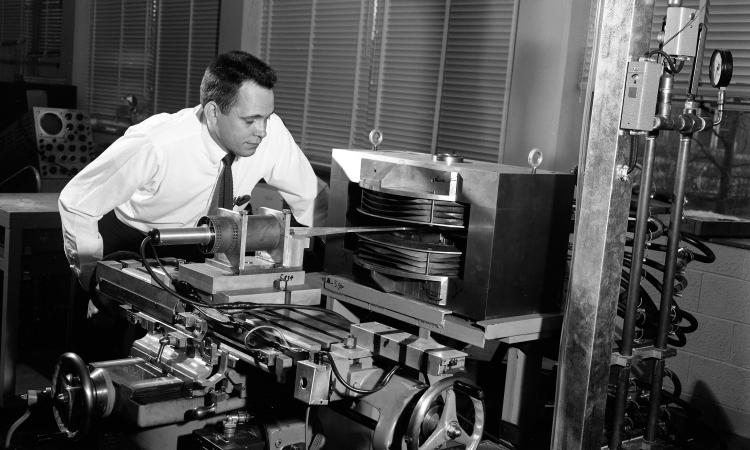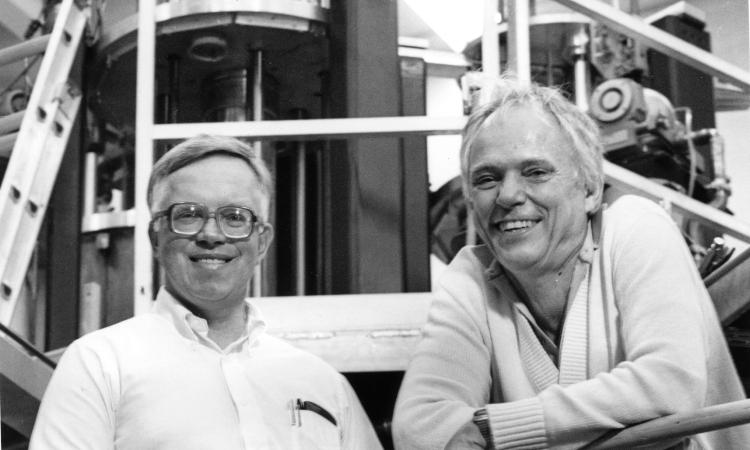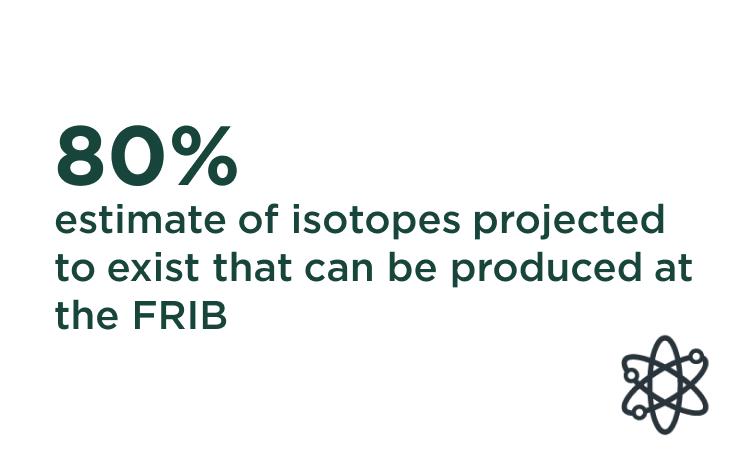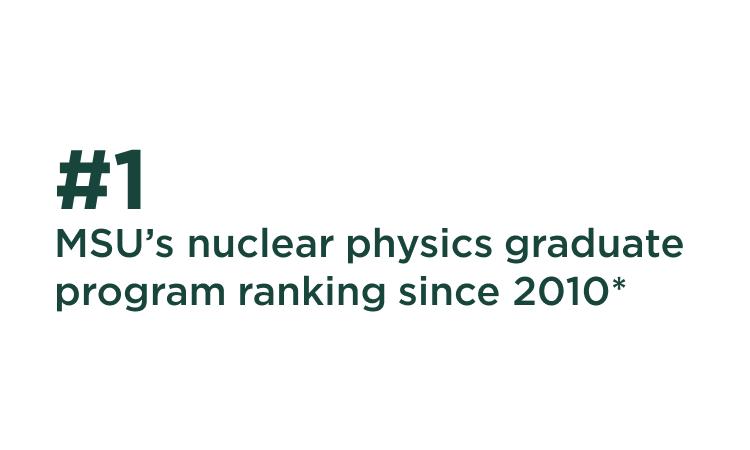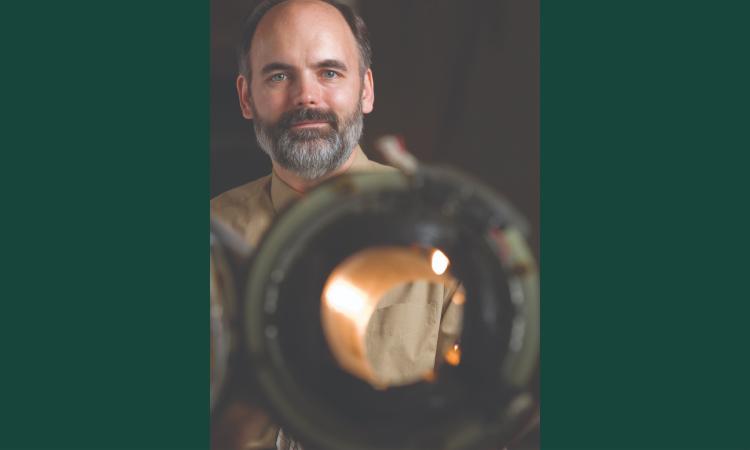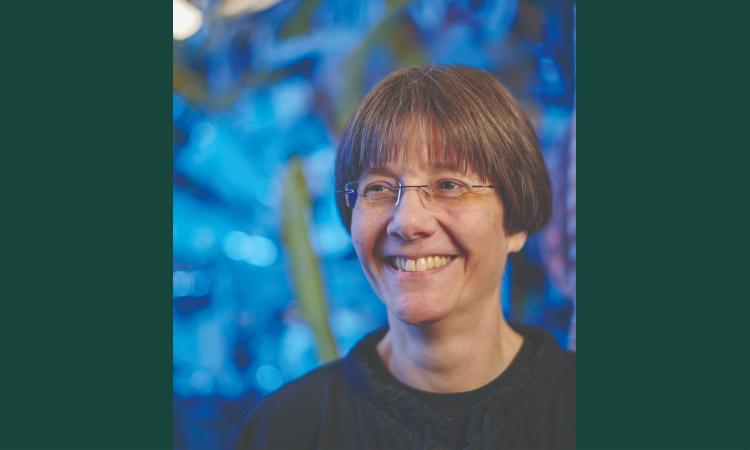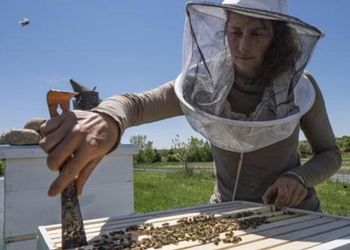Into the Unknown: The Quest for FRIB
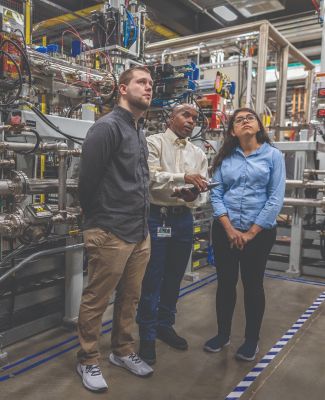
Into the Unknown: The Quest for FRIB
A product of decades of excellence in research and reinvention, the one-of-a-kind Facility for Rare Isotope Beams promises to unlock scientific discovery, serve humanity and propel nuclear physics at—and far beyond—Michigan State University.
September 26, 2022Fourteen years later, Thomas Glasmacher remembers the rain most.
Two hours before stepping outside of a U.S. Department of Energy (DOE) building in Germantown, Maryland, on a December morning in 2008, Glasmacher, then a professor and associate director for operations at MSU’s National Superconducting Cyclotron Laboratory (NSCL), surrendered his cellphone and walked into a nondescript room alongside NSCL Director Konrad Gelbke and Fred Poston, MSU’s vice president for finance and operations. There, the Michigan State trio sat for an hour in uncomfortable, anxiety-inducing silence, awaiting the fate of MSU’s bid to bring a world-first scientific research center—the Facility for Rare Isotope Beams, or FRIB—to East Lansing.
To be certain, MSU stood a long shot to land the $730 million project. Not only was MSU competing against Argonne National Laboratory, a powerhouse DOE research center whose illustrious scientific history included creating the world’s first self-sustaining nuclear reaction (the famed Manhattan Project), but no university had ever successfully competed against a national laboratory for a government-funded research facility of this size and scope.
In traveling to Maryland, the MSU triumvirate clung to hope, but presumed DOE officials merely wanted to give their rejection face to face. But when the representatives finally entered the room, they shared an unexpected verdict: MSU would be home to FRIB.
“It’s rare my brain goes blank, but it did in that moment,” Gelbke said.
Though DOE officials followed with legalese and an overview of the next steps, from an immediate public announcement of the decision to the uneasy particulars of capturing congressional funding, Glasmacher, who had directed MSU’s exhaustive, yearlong effort to compete for FRIB, sat there, speechless and stunned. Minutes later, he, Gelbke and Poston stepped out into the wretched downpour. Mother Nature, it seemed, hadn’t gotten the message—or perhaps had put its money on an Argonne win.
“The rain was such a contrast to the euphoria of the moment, and that’s why it sticks out with me all these years later,” Glasmacher said. “We had the reward of this facility immediately meeting this cold, miserable rain.”
To much fanfare, FRIB—a so-called “discovery machine”—opened its doors earlier this year on the eastern edge of MSU’s campus.
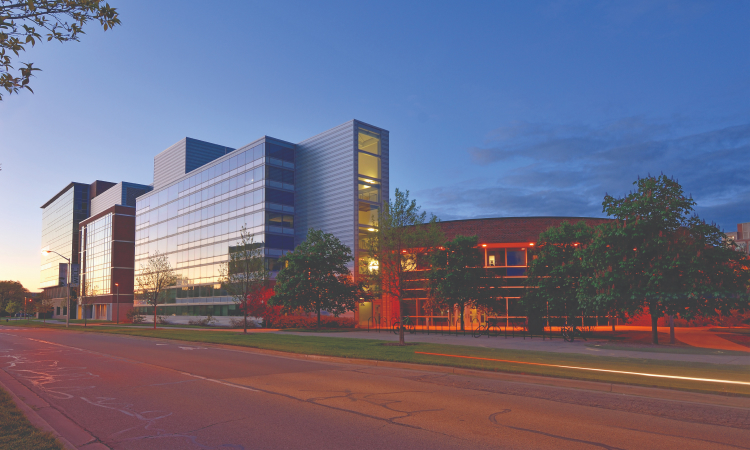
Hosting the world’s most powerful heavy-ion accelerator, one propelling atoms at half the speed of light, FRIB allows scientists from MSU and around the globe to access more than 1,000 never-before-seen isotopes. FRIB-powered research is expected to fuel innovation in fields such as medicine, clean energy, homeland security and environmental science, push discovery in inspiring new directions and cement MSU’s commitment to advancing basic science and benefiting the common good.
THE FOUNDATION
Building a foundation in nuclear physics
When it comes to nuclear physics, MSU inhabits a position unmatched by any U.S. university. Forward-thinking leadership, enterprising scientists and a culture of constant, deliberate reinvention have coalesced over the decades and solidified MSU’s elite standing in nuclear physics, which includes a graduate program ranked as the nation’s best by “U.S. News & World Report” for 13 years running.
It has not always been that way, however.
When Henry Blosser joined MSU’s faculty ranks in 1958, the university had no nuclear physics program to speak of. The Virginia-bred Blosser changed that.
As a leader of Oak Ridge National Laboratory’s Cyclotron Nuclear Research Group in the 1950s, Blosser steered the pioneering development of sector-focused cyclotron accelerators. Then-MSU President John Hannah spotted Blosser’s promise, recruited the 30-year-old scientist to MSU and handed Blosser a mighty task: construct a cyclotron at MSU. Such a creation, Hannah reasoned, would generate valuable research and drive MSU’s standing in the rapidly evolving field of nuclear physics.
As the founding director of MSU’s Cyclotron Laboratory—later renamed NSCL, Blosser built MSU’s nuclear physics program from the ground up. He led the construction of the campus’ original cyclotron accelerator, the K50, in the early 1960s and supported an ambitious research program that consistently attracted top scientists to MSU, whom Blosser then armed with the confidence and freedom to pursue their most far-reaching scientific curiosities.
Simultaneously progressive and pragmatic, Blosser promoted a culture of staying at the forefront of science and technology. He established direct communication lines to university leadership to ensure the lab could act with speed and decisiveness, championed inventive work in novel areas like compact cyclotrons and earned credibility with funding agencies and the global scientific community.
Neither afraid to ask himself “What’s next?” nor challenge others to do the same, Blosser oversaw the development of a more powerful accelerator, the K500, in the late 1970s to unlock new experimentation and discovery. A decade later, the Blosser-led NSCL went bigger again in debuting the K1200 accelerator.
“The lab’s history was always one of taking chances and making inroads into new areas,” said Sam Austin, a former NSCL director who penned a comprehensive history of MSU’s cyclotron work in 2015 titled “Up from Nothing: The Michigan State University Cyclotron Laboratory.”
Under Blosser, in fact, MSU was the world’s first lab to deliver beams of rare isotopes to experiments, and the lab’s efforts spurred breakthrough advancements in areas like magnetic resonance imaging (MRI) and nuclear energy.
“Blosser was a visionary,” said Gelbke, who arrived at MSU in 1977 as an associate professor and served as director of the NSCL from 1992-2015.
Blosser, who retired in 2003 and passed in 2013 days after his 85th birthday, engrained in lab operations a commitment to inquiry, innovation and daring science. That reality showed in the 2001 launch of the Coupled Cyclotron Facility (CCF) pairing the K500 and K1200 accelerators together to empower the study of a bigger range of rare isotopes. The CCF put Michigan State at the forefront of the rare isotope business and positioned it to compete for the FRIB bid seven years later.
“We seized this opportunity to do something better than anyone else,” said Brad Sherrill, the NSCL’s director from 2015-2022.
THE OPPORTUNITY
The Quest for FRIB
With interest in rare isotopes swelling among nuclear physicists around the globe in the 1990s, there emerged growing calls for a more powerful research facility, something NSCL leadership noted themselves as well. There was, however, significant debate among leadership in the field about the right path forward.
MSU went on a multi-year offensive, experimenting and publishing to demonstrate its technique to produce rare isotopes—known as the in-flight production method, which was in place at the existing NSCL—was the best one. Leading with the science, the lab’s researchers published white papers showcasing in-flight production’s value and hinting at the possibilities with a more advanced accelerator.
“By doing the science, we demonstrated how valuable this science was,” Sherrill said.
MSU’s approach earned the endorsement of scientific leaders, subject matter experts and, ultimately, the DOE, which issued a funding opportunity announcement in early 2008 for the construction of a rare isotope-generating facility based on MSU’s technique.
While MSU felt it had the scientific merit to produce a competitive proposal, Gelbke admits some self-preservation was involved as well in deciding to answer the DOE’s call. A new, more powerful facility, after all, would immediately render the NSCL outdated.
“We had to take our shot,” Gelbke said. “It was important to create a long-term scientific trajectory for the lab.”
Glasmacher was appointed to head the effort, the “capture manager” whose sole charge was to land the facility for MSU.
“And if we were going to do this, then we were going to do it to our absolute best capabilities, even if that was painful and tedious,” Glasmacher said.
Over the first half of 2008, Glasmacher and a team of nearly 50 experts—writers, strategists and content scientists among them—collaborated to produce a 750-page proposal precisely aligned to the DOE’s request. Glasmacher, an award-winning physicist with more than 200 publications to his name, preached perfection and simplicity.
“We knew the DOE was only going to read this once, so whatever we didn’t get across was lost,” Glasmacher said.
Weeks after sending the proposal to the DOE in May 2008, the Glasmacher-led team prepped for a summer visit to the DOE’s Maryland office. The proposal group’s painstakingly detailed approach continued with the preparation of 2,000 PowerPoint slides and practice presentations to ensure alignment and accuracy.
Once in Maryland, the MSU contingent met with a panel of seven government officials and 42 subject matter experts. The group grilled MSU representatives on their proposal, digging into particulars of the science, execution and safety plans.
“It was clear they were evaluating our ability and readiness to get this done, and they had no interest in being anything short of thorough,” Glasmacher said.
After the MSU team visited Maryland, it was time for the DOE group to perform a site visit in East Lansing. Once again, Glasmacher and his group labored to craft a calculated, carefully choreographed plan, from the bus route visitors would take to campus to the 20-foot vinyl prints of prospective buildings. Students, meanwhile, held signs compelling MSU’s selection with phrases like “Bring FRIB to Our Crib.”
“We needed to paint the picture that we were the right decision and the ones best qualified to give the highest-value facility,” Glasmacher said.
By the time of the site visit, it was clear MSU was competing one-on-one with Argonne. Though MSU possessed rich experience in the proposed facility’s scientific approach, Argonne held a distinct advantage given its scientific chops and the established history of national laboratories landing these large-scale research facilities. MSU remained the underdog. Even the most optimistic MSU stakeholders pegged the university’s chances at 20%.
After months of silence, the DOE contacted Glasmacher and summoned him to Maryland two days later. As Glasmacher, Gelbke and Poston waited silently in one room, the DOE issued its verdict to the Argonne group in a separate room before informing the three Spartans of MSU’s selection.
After the initial shock of the DOE’s decision waned, Glasmacher said he faced a startling realization. Now, MSU had to build this one-of-a-kind facility.
“I think we all felt the weight of that,” Glasmacher said.
Embracing the same diligent, organized and disciplined approach that won MSU the FRIB nod in the first place, Glasmacher steered a 13-year effort turning the ambitious concept into an on-campus reality. From site excavation to the installation of technical equipment, Glasmacher oversaw every detail of the project with a savvy mix of nerves, persistence and detail.
“We had one shot to do it and we had to do it right,” Gelbke said. “Thomas was just the person for the job.”
Through the Great Recession and a global health pandemic, MSU completed FRIB in January 2022, on budget and ahead of schedule.
THE FRONTIER
Working at the Frontiers of Science
On May 2, about 900 guests, including Michigan political leaders, MSU administrators, MSU trustees and other dignitaries, packed Shaw Lane for the ceremonial opening of FRIB. U.S. Secretary of Energy Jennifer M. Granholm and MSU President Samuel L. Stanley Jr., M.D. cut the ribbon signaling the official start of FRIB’s mission to explore new scientific boundaries, train new scientists and serve humanity.
“Along with boosting the nation’s innovative capacity and global competitiveness, this facility will help us discover new things about our universe and ourselves, find new ways to diagnose and treat cancer and strengthen our national security,” Granholm, the former Michigan governor, beamed.
A week later, FRIB shed the pomp and circumstance and began executing its first experiments.
Producing rare isotopes unfound anywhere else on the planet, FRIB researchers are now starting to test the fundamental interactions and symmetries of nature. The facility is expected to more than double the research opportunities in fields such as nuclear physics, nuclear medicine and homeland security, while also stimulating advancements in astrophysics, plant biology, clean-energy production and advanced radio-frequency systems.
“I’m excited by the possibilities of asking questions and performing experiments that have never been tackled before,” said MSU physics professor Alexandra Gade, whose work investigates the nature of nuclei and how they react.
What’s more, FRIB is a “user facility,” meaning scientists from anywhere can submit proposals to use the facility for their experiments. The FRIB Users Organization (FRIBUO), an independent organization of investigators interested in visiting FRIB to conduct scientific research and develop new technology, already includes more than 1,600 members representing more than 120 U.S. colleges and universities, more than 50 countries and upward of a dozen national laboratories. In its first call for proposals in late 2020, FRIB received 82 submissions from 597 scientists coming from 30 countries and 130 institutions.
Glasmacher called MSU the user community’s “humble servant,” while Gade, who doubles as FRIB’s deputy scientific director, said FRIB seeks to enable powerful scientific research and discoveries above all else.
“We’re opening the door for scientists to explore worlds they’ve never been able to explore before,” said Gade, who serves as a liaison between FRIB and its broad user community.
And while FRIB—perhaps not surprisingly given the uber-detailed approach of its proposal and construction—possesses a defined scientific program, leaders acknowledge the looming presence of scientific serendipity and the novel breakthroughs possible by an accelerator operating at an unprecedented level. Working with exotic structures at the limits of stability, the potential for new knowledge and discoveries soars as science enters the unknown.
“Most exciting isn’t the things we think we’ll find, but the things we didn’t expect to find,” said Dean Lee, a professor of physics at FRIB and prominent nuclear theorist.
When scientists began finding rare isotopes decades ago, no one could foresee the now-ubiquitous applications ahead, such as smoke detectors, sterile bandages or advancements in cancer diagnosis and treatments. Today, the wonder of discovery, the possibilities for science to penetrate the unknown, energizes the FRIB community.
“We think we know why we’re building FRIB,” said Sherrill, now FRIB’s scientific director. “When you explore science that has never been done before, though, there will be things we didn’t anticipate, and that’s what is most invigorating of all.”
HEAR MORE:
Contributing Writer(s): Daniel P. Smith




